1. The Nagara River; ‘Satokawa’ of Gifu Prefecture
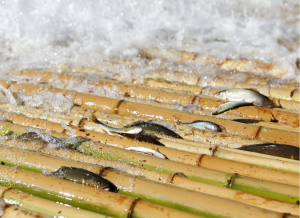 Gifu Prefecture is near the centre of Japan and prides itself on having the seventh largest size by land area and is one of the few inland prefectures surrounded by seven prefectures. The population of Gifu is two million, ranking 17th largest in Japan.
Gifu Prefecture is near the centre of Japan and prides itself on having the seventh largest size by land area and is one of the few inland prefectures surrounded by seven prefectures. The population of Gifu is two million, ranking 17th largest in Japan.
In Japan, rivers that retain their economic value, spiritual value and biodiversity through the involvement of human activities are called ‘satokawa’. The Nagara River is a satokawa located in the centre of Gifu Prefecture and on the upper and middle courses of thriving inland fisheries, which revolve around a species of Japanese ‘sweetfish’ called “ayu”. The clear water of the river is kept clean by the water quality conservation activities of the people living in the basin, and ayu fish grow in the clear water, and the local people enjoy the benefits of ayu fish. In December 2015, the Food and Agriculture Organisation of the United Nations (FAO) recognised the area as ‘The Nagara River System’ in recognition of this synergy of the local lifestyle, the aquatic environment and fisheries resources and as a Globally Important Agricultural Heritage System (GIAHS).
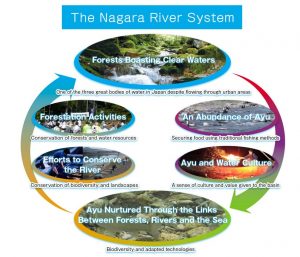 The Globally Important Agricultural Heritage Systems (GIAHS) is a project initiated by the Food and Agriculture Organization of the United Nations (headquartered in Rome, Italy), which aims to ensure food stability.
The Globally Important Agricultural Heritage Systems (GIAHS) is a project initiated by the Food and Agriculture Organization of the United Nations (headquartered in Rome, Italy), which aims to ensure food stability.
2.’Ayu’ as a fishery resource
The ayu fish is found only in East Asia, and its main distribution area is Japan. It is a migratory fish that moves between the sea and the river, and because it lives in the upper and middle reaches of the river where the water is clean during its life in the river, it has been rooted in the lives of the Japanese people since ancient times as a blessing of clear water. Ayu from the Nagara River is one of the most famous products in Japan, and even today, the catch and brand power of ayu from the Nagara River is one of the highest in the country.
It is the second most fished species of river fish in Japan. In recent years, however, ayu numbers have been declining domestically and internationally, and there are concerns that they may become extinct in some areas. Under these conditions, the conservation of the ayu stocks on the Nagara River involves the maintenance and preservation of the environment and spawning grounds, the artificial hatching and release of ayu from the indigenous population, and the provision of opportunities to view the spawning grounds. This type of protection of ayu habitats is also linked to the conservation of other, sometimes rare, fish species. It has a positive impact on the biodiversity of the region as a whole.
3. History and culture fostered by clear waters
The water, in tandem with agriculture, forestry and fisheries, is the source for traditions such as a traditional fishing method, ‘ukai’ (cormorant fishing), Mino Washi Japanese paper and other traditional crafts. Water also plays a role in religious practice and traditional forms of entertainment etc. The combination of all of this together creates a unique history and culture which continues to live today.
(1) Gifu Cormorant Fishing on the Nagara River
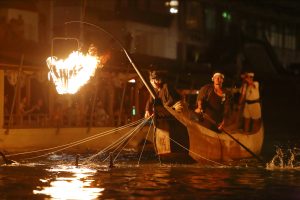
This is one of the traditional river fisheries practised for over 1,300 years, taking advantage of the cormorant’s habit of eating the fish whole. The brightness of the bonfire and the sound of the boatman tapping on the boat makes the ayu slip, and when it glows in the water, the cormorant dives in and catches it. The bonfires in the darkness and the fantastic sight of the traditional fishing method are celebrated by many people as a local Gifu tradition and viewed by many visitors, including Prince Edward in 1922 and Chaplin in 1936 and 1961.
(2) Mino Washi Japanese paper
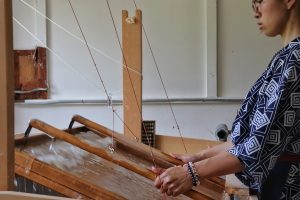 Mino Washi is a style of traditional Japanese paper that has long been produced in the city of Mino for over 1,300 years. It is particularly famous for its pure white colour and ability to showcase light beautifully while maintaining a tough and durable consistency. Its production methods were designated a UNESCO Intangible Cultural Heritage in 2014; only three washi styles in Japan have received the honour. Traditionally the paper was used for shoji sliding paper doors in the temples of shrines of Kyoto and for local Gifu crafting industries like uchiwa paper fans, wagasa paper umbrellas, and most notably, chochin paper lanterns. Today, Mino Washi has been used in restoring East Asian artwork at the British Museum, the Louvre Museum, and the Smithsonian Museum.
Mino Washi is a style of traditional Japanese paper that has long been produced in the city of Mino for over 1,300 years. It is particularly famous for its pure white colour and ability to showcase light beautifully while maintaining a tough and durable consistency. Its production methods were designated a UNESCO Intangible Cultural Heritage in 2014; only three washi styles in Japan have received the honour. Traditionally the paper was used for shoji sliding paper doors in the temples of shrines of Kyoto and for local Gifu crafting industries like uchiwa paper fans, wagasa paper umbrellas, and most notably, chochin paper lanterns. Today, Mino Washi has been used in restoring East Asian artwork at the British Museum, the Louvre Museum, and the Smithsonian Museum.
4. Initiatives of the Gifu Prefecture Government
The Gifu Prefectural Government is working with the agricultural, food industry, commercial and industrial organisations and the prefecture to conserve the environment, train successors, and increase demand to protect local specialities such as ayu, Hida beef and persimmons while revitalising the economy.
(1) Passing on to the next generation; establishment of ‘GIAHS Nagara River Ayu Park.’
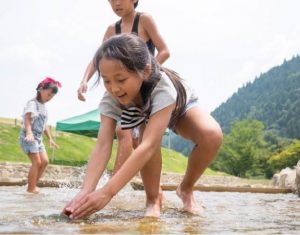
GIAHS Nagara River Ayu Park was established in 2018 to promote and develop the fishery industry of the prefecture, including the ayu fishery, through hands-on learning that allows visitors to become familiar with the river and its fish and also to serve as a base for disseminating information on the GIAHS “Ayu of the Nagara River System”.
(2) Raising awareness and increasing exports;
Since 2009, a strategic overseas project has been developed by promoting the trinity of tourism, food and prefectural products to increase awareness and demand overseas. The Governor of Gifu Prefecture and other officials visit department stores, major food wholesalers and restaurants in Asia, the EU, North America and Australia to give cooking classes to restaurant chefs and promote the products to local people, thereby building cooperative relationships with local people and laying the foundations for producers to expand overseas.
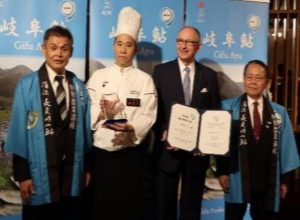
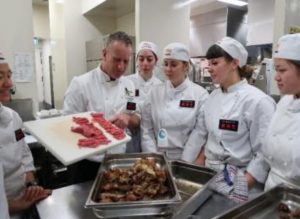
These efforts have been successful, with the amount of ayu fish exported increasing from 0.01 tonnes in 2013 to 1.42 tonnes in 2018. Unfortunately, due to COVID-19, this figure decreased in 2019, but our efforts will continue.
The clear Nagara River and its symbol, the ayu, which have sustained the lives of the people living in the watershed and been protected by the activities of those living there, are irreplaceable treasures for Gifu Prefecture.
(Reference links)
GIAHS Ayu of the Nagara River System Website
Japan experience unfolds – SDGs practice

